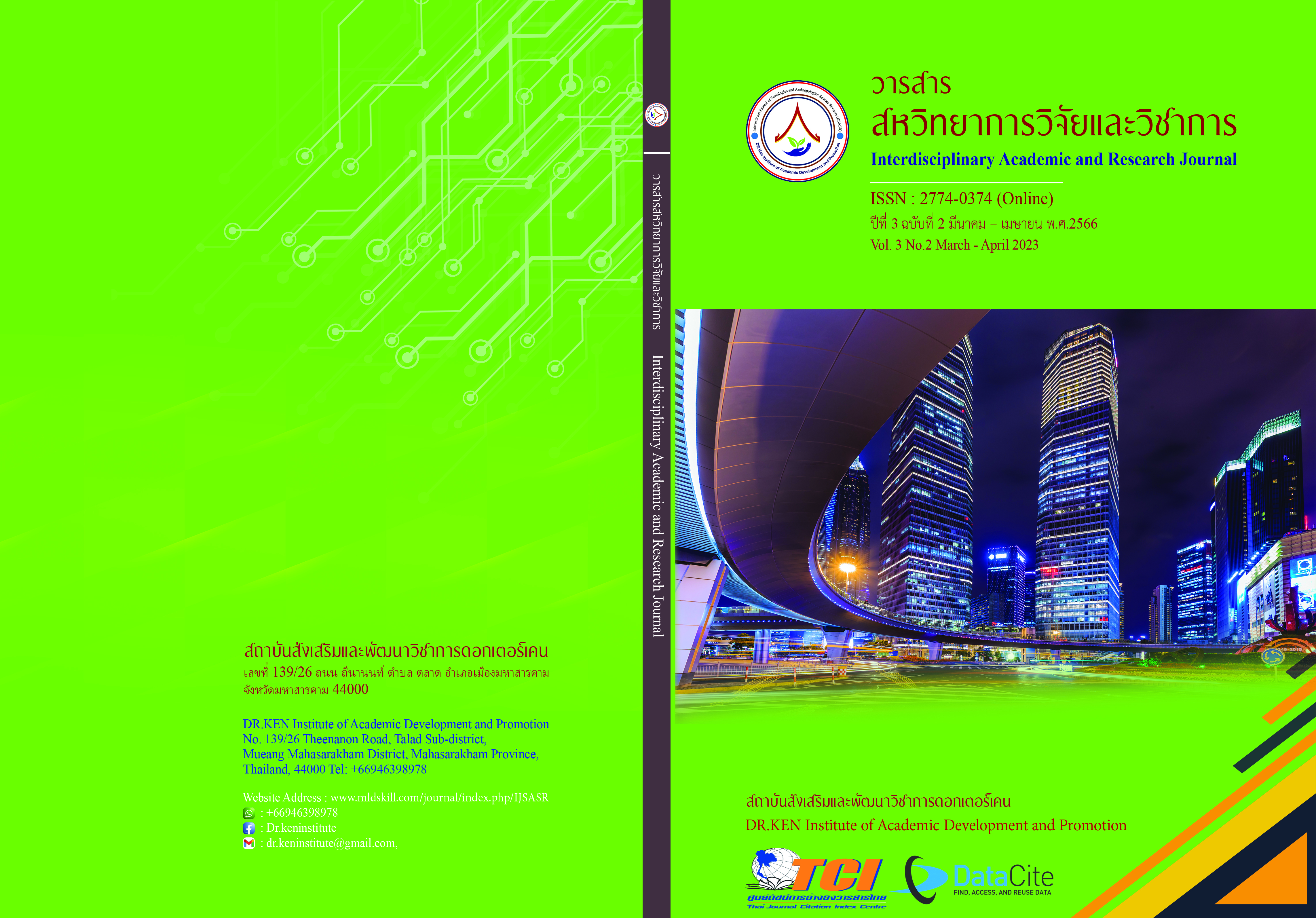Groundwater Bank Innovation in Water Resource Management in the Northeast Region
DOI:
https://doi.org/10.14456/iarj.2023.59Keywords:
Social Innovation; , Groundwater Bank; , Management; , Water ResourcesAbstract
The underground water bank is an initiative of His Majesty King Rama IX. There are two types of groundwater banks: closed system groundwater banks, and open system groundwater banks, if the two types of groundwater banks are used together, it will be the most effective. However, there are 10 provinces in the northeastern region suffer from drought, therefore, it is necessary to take measures to solve water problems sustainably with the philosophy of sufficiency economy, creating a balance between conservation and rehabilitation, and water resource development. Therefore, this research aims to (1) To find and explore groundwater bank innovations in water resource management in the Northeast. (2) To study success factors and suggestions for the development of groundwater bank innovation in water resource management in the Northeast. And (3) To confirm the groundwater bank innovative model for water resource management in the Northeast. This research used qualitative research divided into 3 phases namely; Phase 1: Search and explore groundwater bank innovations in water resource management in the Northeast. Phase 2: study of success factors and suggestions for the development of groundwater bank innovation in water resource management in the Northeast, the target group is a group of 25 government representatives, experts, community/civil society representatives. The research tools used in-depth interviews and focus groups. And Phase 3 Confirmation of the groundwater bank innovative model for water resource management in the northeastern region through expert assessment. The results showed that (1) Finding and exploring groundwater bank innovations in water resource management in the Northeast, namely; (A) survey of spatial potential, (B) Design of an underground water bank system, (C) building groundwater banks, (D) monitoring and evaluation, and (E) Further development. (2) Success factors and recommendations for the development of groundwater bank innovation in water resource management in the Northeast are as follows; (A) Participation development has a development approach consisting of; public relations to create awareness, integration between local communities, academics and the private sector, Build a sense of belonging, build a network of philosophers, and farmers expand the groundwater community network. (B) Knowledge development has a development approach consisting of; analysis of geophysical potential, exploring additional water sources, developing groundwater balance accounts, Develop a draft of an underground water bank, prepare an open and closed groundwater bank. (C) In terms of technology development, development guidelines include; developing a water observation pond, developing a water level monitoring system with APPLIICATIONIOT, developing a ground water diversion system with a Solar Cell system, developing an IOT device to send signals to monitor water levels, creating a Line group. in informing information. (D) in terms of the development of the groundwater bank fund, there are development guidelines, consisting of; setting up a water fund management committee, transferring to the Children and Youth Council, study visits at Best practice locations, build a community groundwater bank learning resource, and evaluate fund performance. And (E) in the development of water use planning, there are development guidelines, consisting of; creating a sub-district water route plan, groundwater balance accounting planning, utilization indicators, risk management planning, planning and other water utilization projects. And (3) The experts had their opinions on the groundwater bank innovation development approach for water resource management in the Northeastern region consistent with the median between 4.00-5.00, the consistency level of responses with the highest frequency was 5.00, and the interquartile range was less than 1.5.
References
กำแหง วัฒนเสน, สุรพล อารีย์กุล และ วรวุฒิ โลหะวิจารณ์ (2555). การสำรวจหาแหล่งน้ำใต้ดินในชั้นหินแข็งโดยวิธีการสำรวจข้อมูลระยะไกลและวิธีธรณีฟิสิกส์ในพื้นที่ปลูกพืชเศรษฐกิจ อำเภอรัตภูมิ ทางทิศตะวันตกของทะเลสาบสงขลา. สำนักงานคณะกรรมการส่งเสริมวิทยาศาสตร์ วิจัยและนวัตกรรม.
จันทรา ชัยชนะ. (2563). ปัจจัยที่ส่งผลต่อประสิทธิผลการบริหารจัดการธนาคารน้ำใต้ดินจังหวัดยโสธร. วิทยานิพนธ์ปริญญารัฐประศาสนศาสตรมหาบัณฑิต. มหาสารคาม : มหาวิทยาลัยราชภัฏมหาสารคาม.
ชาตรี๊ ศรีวิชาฐา และคณะ. (2561). ตำบลต้นแบบการบริหารจัดการน้ำนอกเขตชลประทานด้วยระบบธนาคารน้ำใต้ดิน (GROUNDWATER BANK) ตามปรัชญาของเศรษฐกิจพอเพียงด้วยศาสตร์พระราชาองค์การบริหารส่วนตำบลเก่าขามอำเภอน้ำยืน จังหวัดอุบลราชธานี. อุบลราชธานี : บริษัทเส้นทาง จำกัด.
เทอดศักดิ์ เจียมกิจวัฒนา. (2561). ธนาคารน้ำของพ่อ ช่วยคนไทยรอดน้ำท่วม. Retrieved from : https://www.facebook.com/vihoktherdsak/photos/a.579092058795007/1837118752992325/?type=3.
นริศรินทร พันธเพชร. (2564). รูปแบบการจัดการโครงการธนาคารน้ำใต้ดินอย่างยั่งยืนของจังหวัดยโสธร. วารสารสังคมศาสตร์และมานุษยวิทยาเชิงพุทธ. 6(3), 93 – 105.
พิมพ์พิสุทธิ์ อ้วนล้ำ และคณะ. (2560). การจัดการความรู้เพื่อการบริหารจัดการน้ำสู่ความเข้มแข็งของชุมชนและพึ่งตนเองด้านแหล่งน้ำอย่างยั่งยืน กรณีศึกษา โครงการธนาคารน้ำใต้ดิน (Ground water bank) บ้านค้ากลาง ตำบลเก่าขาม อำเภอน้ำยืน จังหวัดอุบลราชธานี. สำนักงานคณะกรรมการวิจัยแห่งชาติ.
สยามรัฐออนไลน์. (2563). "เฉลิมชัย" รับลูกนายกฯ ลุยแก้แล้งปี 63 สั่งเพิ่มแหล่งเก็บกักน้ำ. Retrieved from : https://siamrath.co.th/n/137140.
สำนักงานคณะกรรมการพัฒนาการเศรษฐกิจและสังคมแห่งชาติ. (2561). ยุทธศาสตร์ชาติ 20 ปี พ.ศ. 2561-2580. กรุงเทพฯ : สำนักงานคณะกรรมการพัฒนาการเศรษฐกิจและสังคมแห่งชาติ.
สำนักงานทรัพยากรน้ำแห่งชาติ. (2562). แผนแม่บทการบริหารจัดการทรัพยากรน้ำ 20 ปี (พ.ศ. 2561 - 2580). กรุงเทพฯ : สำนักงานทรัพยากรน้ำแห่งชาติ.
เสาวลักษณ์ โกศลกิตติอัมพร, สัญญา เคณาภูมิ, วาสนา บันลือหาญ, และอาภากร ประจันตะเสน. (2563). การจัดการทรัพยากรน้ำ: แนวคิดธนาคารน้ำใต้ดินจากชุมชนเก่าขามอุบลราชธานีสู่ชุมชนหนองมะโมงชัยนาท. วารสาร มจรอุบลปริทรรศน์. 5(1), 395 – 408.
Downloads
Published
How to Cite
Issue
Section
License
Copyright (c) 2023 ธนกฤต รุ่งแสนทวี, สัญญา เคณาภูมิ, เสาวลักษณ์ โกศลกิตติอัมพร

This work is licensed under a Creative Commons Attribution-NonCommercial-NoDerivatives 4.0 International License.
Copyright on any article in the Interdisciplinary Academic and Research Journal is retained by the author(s) under the under the Creative Commons Attribution-NonCommercial-NoDerivatives 4.0 International License. Permission to use text, content, images, etc. of publication. Any user to read, download, copy, distribute, print, search, or link to the full texts of articles, crawl them for indexing, pass them as data to software, or use them for any other lawful purpose. But do not use it for commercial use or with the intent to benefit any business.
















.png)


